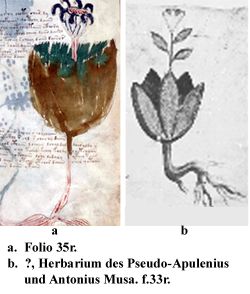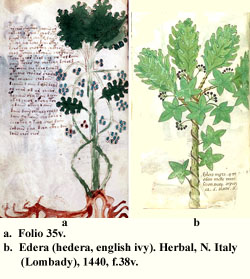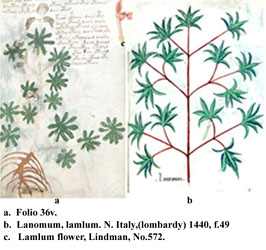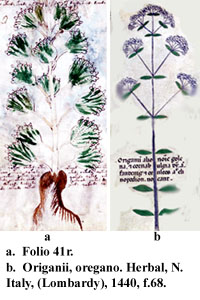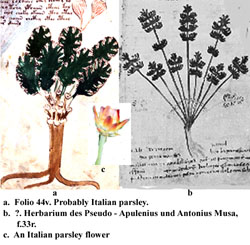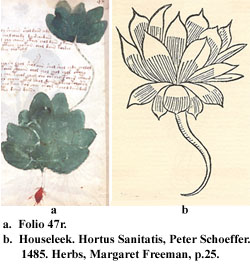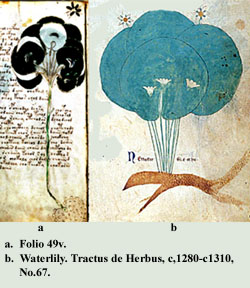The Voynich Botanical Plants
Folio 31v. Fennel (Foeniculum vulgare). The bulb, seeds and leaves of this plant were used to flavor many culinary dishes “Medieval herbalists state that fennel seed comforteth the stomach. Also if it be drunk with wine it will break the dropsy and all manner of swellings. It was good for mistiness of the eyes and worms in the ears, It makes a woman’s milk to increase.” (2) (A)
Folio 35r. The identity of this plant is not known. (A)
Folio 35v. English ivy (Hedera helix). “Pseudo-Apuleius explains that earth ivy is good for the stones in the bladder, for sore of the milt and for bite of creeping things; also it is used in case the nostrils smell ill, or in case a man is not able to hear well and that the head may not ache from the heat of the sun. Bancker’s Herbal adds that if it be sodden in swine’s grease, it is good for all manner of things.” (2) (A)
Folio 36r. Larkspur (Delphinium). “The medieval writer on agriculture, Petrus de Crescentius, claimed that a paste made from larkspur seads and vinegar was good for treating head lice and scabies and the powered seeds when mixed with honey and taken internally killed worms.” (2) (A)
Folio 36v. Henbit (Lasmium) is a useful plant in the garden for repelling insects. It makes an edible spring green and is a mild astringent. (A)
Folio 37v. Mint (Menthe). There are many different species of mint. Bankers Herbal describes how if mint is rubbed on the teeth it will “give a sweet smelling mouth; made into a sauce it will make thee have a talent (appetite) to thy meat; used in a poultice it will cure blotches on the face;” “Mint is good for toothache, it is used to prevent vomiting. If it be oft eaten it will slay worms.” (2) (A)
Folio 41r. Oregano/marjoram (Origamum vulgare). Oregano in medieval times, like today, was an important herb for flavoring soups, stews and salads and “before the discovery of hops it was used in the brewing of beer. It was attached to the head to cure a cold and when drunk with wine it warmed the stomach and comforted the digestion It was grown for its flavour and beauty.” (2) (A)
Folio 44v. Italian parsley (Petroselinum. crispun var. neapolitanum) is a flat leafed parsley with slender stems. It has more flavor than the curly leafed variety. Parsley is a good source of vitamins A, B, and C and iron. Teas are used as a diuretic and medications for kidney stones, bladder infections and jaundice. Pregnant women should avoid parsley as it can irritate the kidneys. (1) Bancker’s Herbal states that it “multiplieth a man’s blood…it is good for the side and the dropsy. It comforteth the heart and the stomach.” (2) (A)
Folio 47r. Houseleek ( Sempervivum tectorum). The juice from this succulent plant was used to soothe burns, bites, stings and a variety of skin conditions.” Dioscorides recommended it for inflammation of the eyes, feet gouts, hemorrhage and headaches. Crescentius notes that the “juice laid on hot ulcers drives away infection … mixed with oil of roses is good for burns.” Hortus Sanitatis states that “who ever is deaf should take the milk of a woman nursing a 10 to 12 week old boy and put with this the juice of the houseleek and the drip 3 or 4 drops in the ear soothingly and hearing will return.” (2) (A)
Folio 49v. Water lily (Nymphaea alba). There is also a red variety of this water lily. The alkaloids extracted from the rhizomes and flowers are used as astringents, antiseptics, anti-aphrodisiacs and sedatives. For centuries monks and nuns have used the crushed roots with wine for its anti-aphrodisiac properties. (1) (A)

